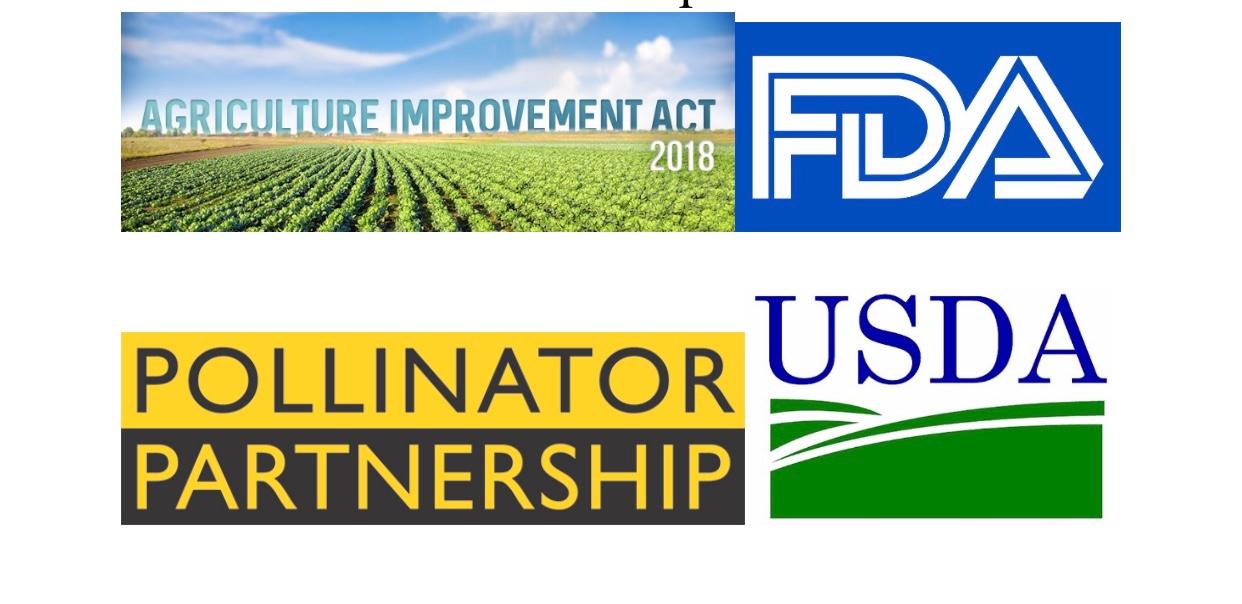By: R. Thomas (Tom) Van Arsdall
Director of Public Affairs, and
Val Dolcini
President & CEO
The Pollinator Partnership
Tom Van Arsdall from the Pollinator Partnership (P2) has waded through the 807 pages of the Farm Bill now headed to the President’s office for signing. We asked P2 if the bill had any radical changes, good or bad, for pollinators in general compared to the bill passed 5 years ago. Here is the summary of their evaluation.
Summary:
• Reauthorizes Pollinator conservation and research provisions enacted in the 2008 and 2014 farm bill (P2 leading role in each)
• Adds major new, enhanced coordination of honeybee/pollinator research provisions under the USDA Chief Scientist (advocated by AHPA, supported by P2)
o New Honey Bee and Pollinator Research Coordinator established in Office of the Chief Scientist.
o “Implement and coordinate research efforts per recommendation of the Pollinator Health Task Force.”
o Provides specific direction on the scope of research to be conducted and coordinated (SEE legislative language excerpts)
• Adds specialty crop pollinators eligibility to Specialty Crops Research Initiative
• Adds habitat for honey bees and other pollinators under supplemental and alternative crops section
• Does NOT include major provision that was in the Senate-passed farm bill, which essentially would have codified in detail the Pollinator Health Task Force/Strategy implemented pursuant to the Presidential Memorandum on Honey Bee and Pollinator Health.
o In addition to reference to the Pollinator Health Task Force in research language (cited above), the joint statement of managers encourages “the continuation of interagency collaboration and policy development as recommended by the Pollinator Health Task Force.”
o So at least the Presidential Memorandum, National Strategy on Honey Bee and Pollinator Health and the Pollinator Health Task Force remain in effect (no harm done).
• There’s also language clarifying that beekeepers qualify for ELAP, and clarifying what constitutes covered losses.
• While language in the Joint Statement of Managers doesn’t have force of law, it does provide clarification on legislative language decisions, plus intent of the conferees. This can be useful in advocacy efforts during implementation.
• Lots of other provisions in the farm bill can benefit/impact honey bees and other pollinators that were generally encouraging. For example –
o CRP cap will increase from 24 to 27 million acres. However, payment rates will be limited to 85% of rental rates, making CRP less attractive choice.
o Conservation Stewardship Program (CSP), to continue, but at reduced funding.
o Foundation for Food and Agriculture Research (FFAR), an additional $185 million provided (FFAR announced last spring $15 million in leveraged funds for pollinator research).
P2 hasn’t had a chance to track down the specific sections of law referenced in the legislative language [sometimes just reference to sections being amended or deleted]. For example, according to news reports, reportedly no more cost-share assistance will be provided to growers for pollinator mixes for CRP (CP-42), largely due to excessive cost. Not able to confirm at this point.
“P2 has been concerned about excessive cost of CP-42 pollinator mix and appreciates conferees’ statements urging USDA to develop more affordable mixes for honey bee and pollinator forage.”
By: R. Thomas (Tom) Van Arsdall, Director of Public Affairs, and
Val Dolcini, President & CEO
The Pollinator Partnership
***************
Other provisions not directly affecting pollinators, but certainly bees and beekeeping, were shared with us by other groups including the following –
Taking a bipartisan approach in the crafting of their measure, The Senate Agriculture Committee included many provisions important to our industry:
• $80 million in funding for all specialty crops under the Specialty Crop Research Initiative (SCRI) and new prioritization for mechanization projects
$25 million annually for citrus greening research through the Emergency Citrus Disease Research and Development Trust Fund
$4 million annually for a new research initiative focusing on urban agriculture
Reauthorization of the Office of Pest Management Policy
Full $85 million in funding for the Specialty Crop Block Grant Program (SCBGP) with $5 million set aside for multi-state programs to be administered through the Agricultural Marketing Service (AMS)
An increase to $50 million in mandatory funding for the Food Insecurity Nutrition Incentive Program (FINI)
Full funding for trade programs such as the Market Access Program (MAP) and the Technical Assistance for Specialty Crops Program (TASC)
The No Added Sugar change was welcomed by the both the beekeeping and maple syrup industries, if not the FDA and AMS sections of the USDA.
The new farm bill prevents maple syrup and honey producers from being required to list their pure products as containing added sugars on their nutrition labels — a plan proposed by the U.S. Food and Drug Administration months ago that producers said was misleading.
The FDA’s goal was to update the Nutrition Facts label on products to educate consumers about the amount of added sugars in foods based on government dietary guidelines. However, no sugar is added to pure maple syrup or honey.
After getting thousands of comments on the draft plan, the FDA acknowledged in June the labeling was confusing and said it would come up with an alternative approach for maple syrup and honey.
“This was a huge mistake by the FDA so we got a common sense outcome to the pretty witless labeling requirement,” maple syrup producers said, echoed by beekeepers everywhere.
The farm bill exempts “any single-ingredient sugar, honey, agave, or syrup” that is packaged and offered for sale as a single-ingredient food from bearing the declaration ‘includes X g Added Sugars” in the nutrition label.
The FDA said in a written statement that it does not comment on pending legislation. It said it was drafting its final guidance, which it anticipates issuing by early next year.
“This guidance will provide a path forward for pure, single-ingredient ‘packaged as such’ products that does not involve the standard ‘added sugars’ declaration on the Nutrition Facts label,” the statement said.









